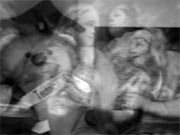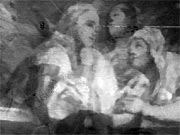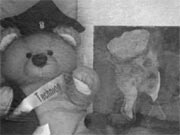Yoav Y. Schechner: Research
Semi-Reflections: Polarization-based Separation

When a semireflecting surface (e.g., a glass window) is present between an observer and an object, an image reflected by the surface may be superimposed on the observed object. We analyze the polarization effects in such scenarios, taking into account internal reflections within the semireflecting medium. Subsequently, we present an approach to recover the scene layers. Moreover, it automotically classifies (labels) which of the recovered the layers is the reflected/transmitted one.
The approach is based on imaging through a polarizing filter at two orientations. Estimates of the separate layers are obtained by analysis of these images, inverting the image formation process. This analysis, however, requires the estimation of the orientation (inclination and tilt angles) of the transparent (invisible) surface. The inclination angle is estimated by seeking the value that leads to the minimal mutual information of the estimated layers.
This method, presented in 1999, is related to independent component analysis (ICA). However, since it incorporates physical considerations, our method does not suffer from ambiguities of ICA (scale, sign and permutation). The work also includes analysis of limitations, noise and angle errors, including a fundamental ambiguity in the determination of the plane of incidence. Experimental results demonstrate the success of angle estimation and consequent scene separation and labeling.
Publications
- Yoav Y. Schechner, Joseph Shamir and Nahum Kiryati, “Polarization and statistical analysis of scenes containing a semi-reflector,” Journal of the Optical Society of America A 17, pp. 276-284 (2000).
- Yoav Y. Schechner, Nahum Kiryati and Joseph Shamir, “Multi-valued images and their separation,” Multi-Image Analysis, Lecture Notes on Computer Science Vol. 2032, pp. 129-141 (2000), Editors: R. Klette, T. Huang, and G. Gimel'farb.
- Yoav Y. Schechner, Joseph Shamir and Nahum Kiryati, “Polarization-based decorrelation of transparent layers: The inclination angle of an invisible surface,” Proc. ICCV, pp. 814-819 (1999).
- Yoav Y. Schechner, Nahum Kiryati and Joseph Shamir, “Separation of transparent layers by polarization analysis,” Proc. SCIA, Vol. 1, pp. 235-242 (1999).
- Yoav Y. Schechner, Joseph Shamir and Nahum Kiryati, “Vision through semi-reflecting media: Polarization analysis,” Optics Letters 24, pp. 1088-1090 (1999).
Presentations
- “Semi-Reflections: Polarization-based Separation” (1.9 Mb, PowerPoint)
Downloads
- Image Database (4.2 Mb .tar.gz)




